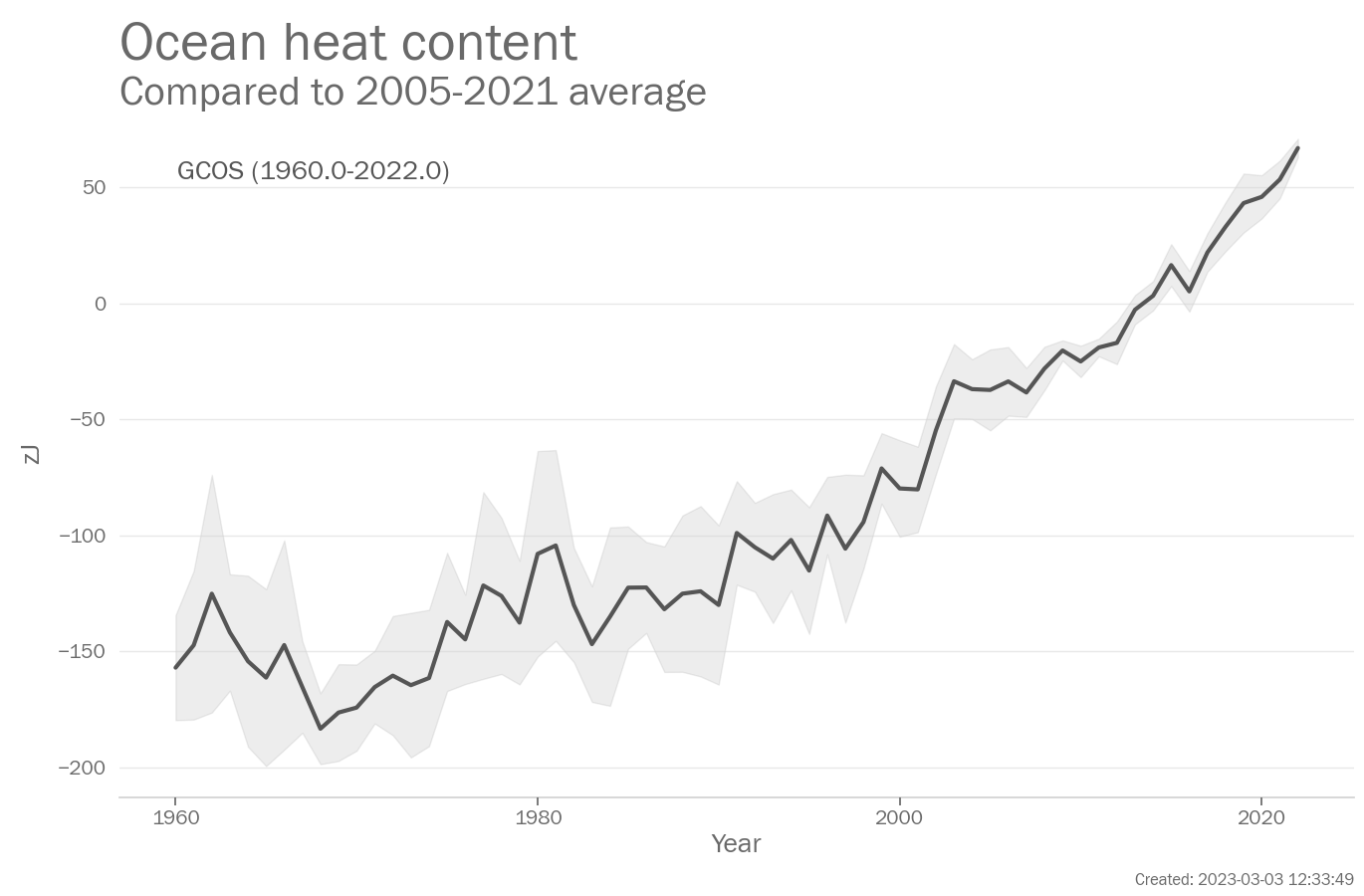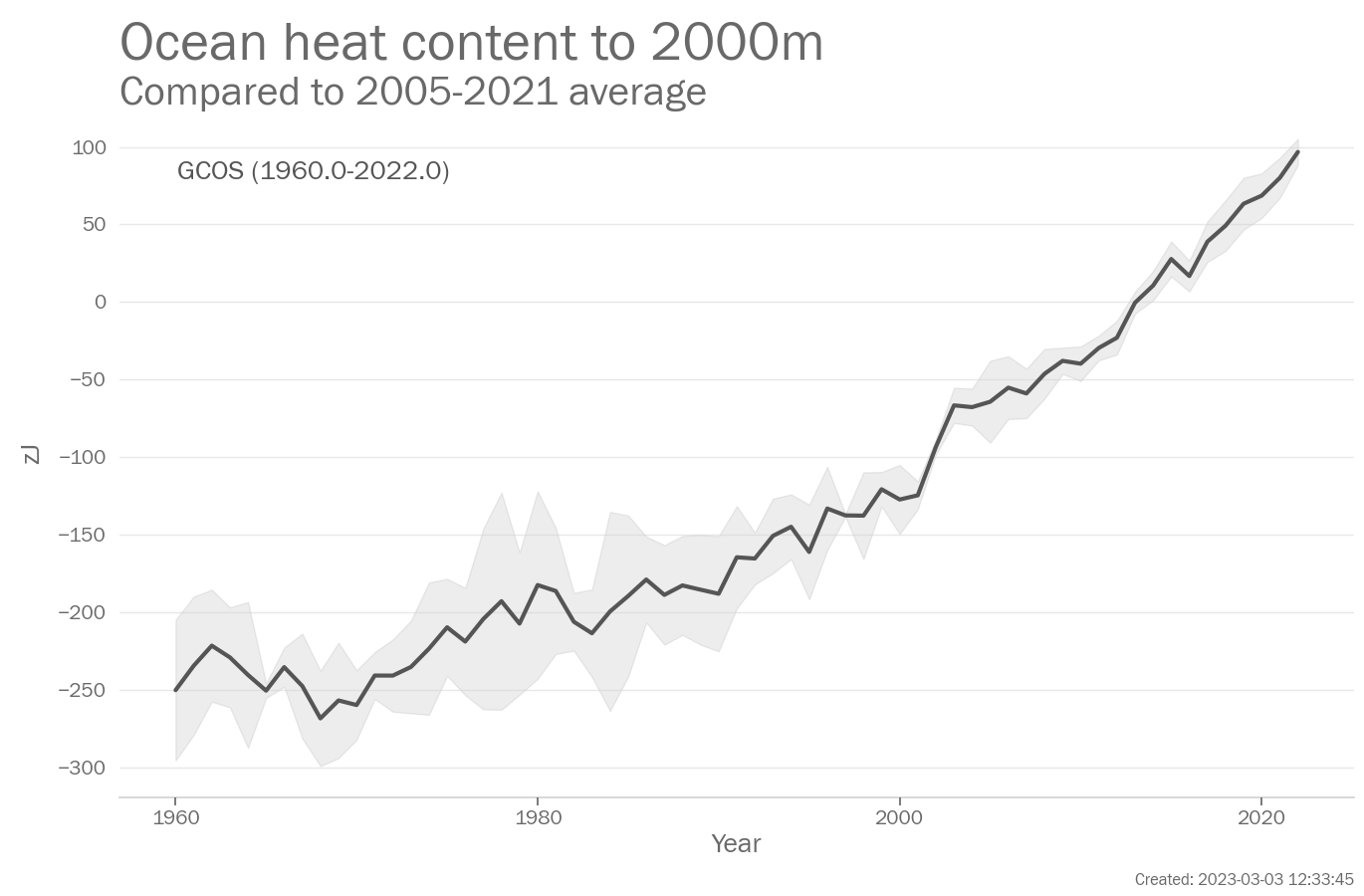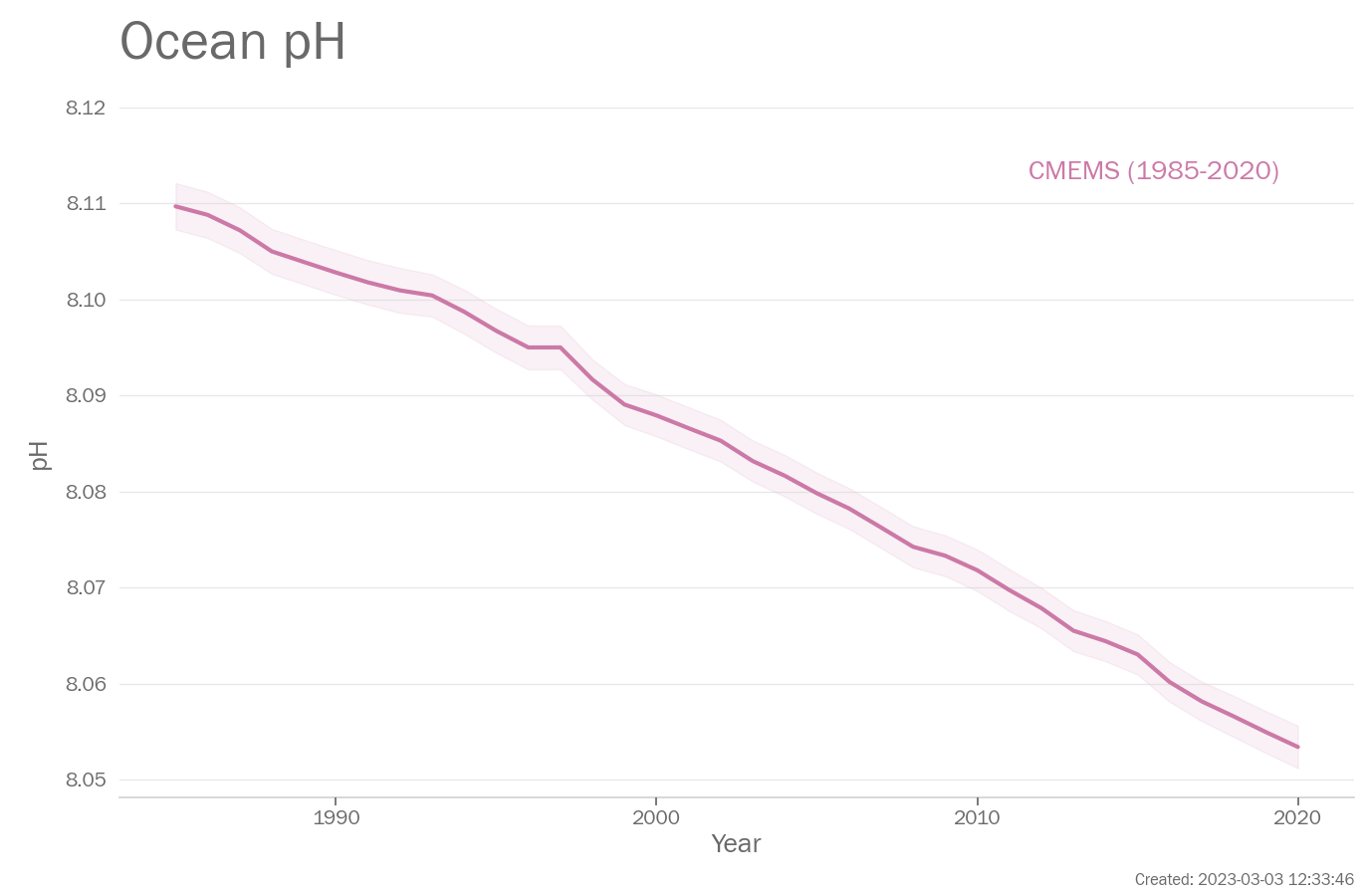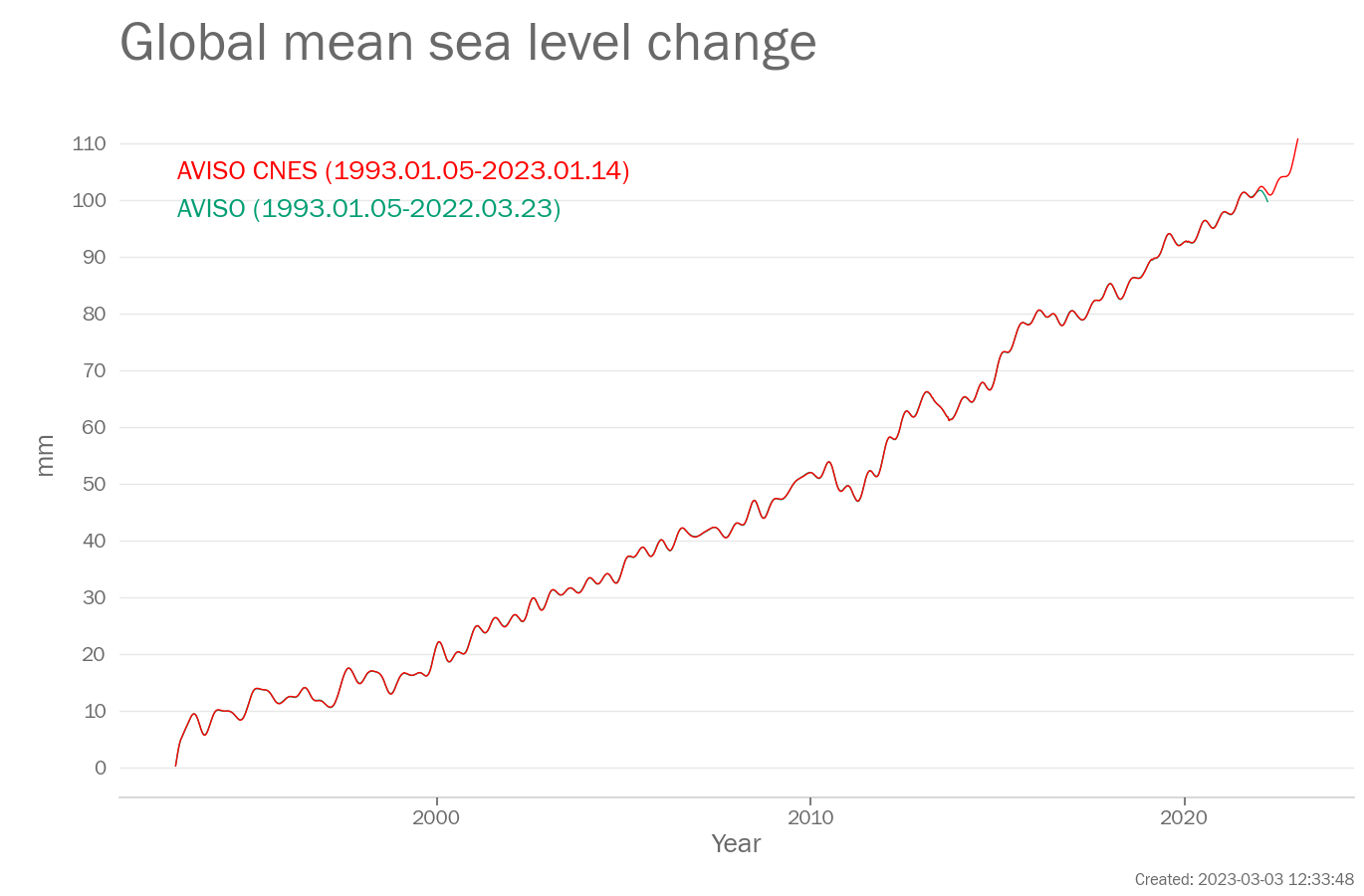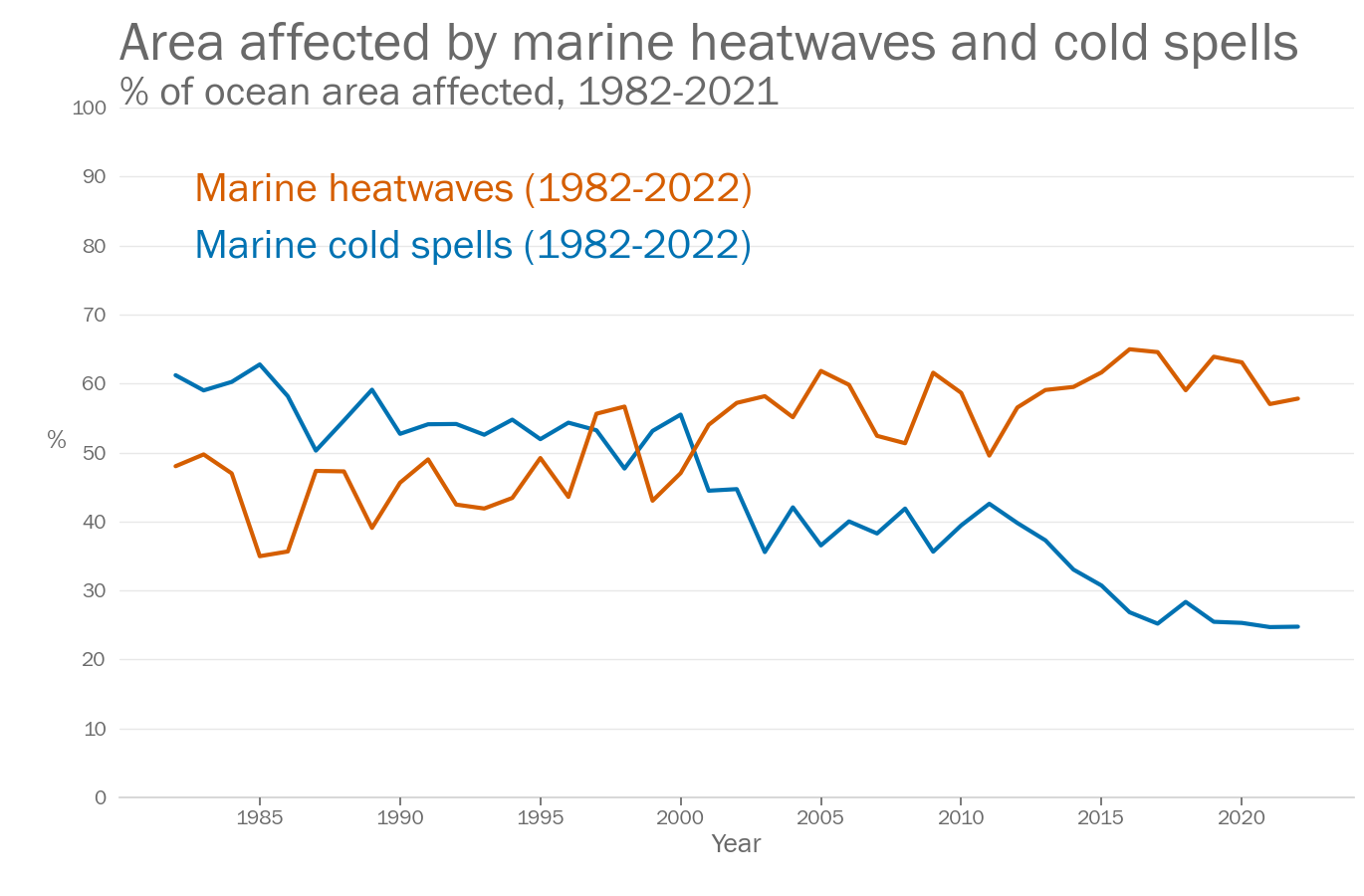Ocean Indicators
Introduction
The ocean covers nearly 70% of the Earth's surface. Most of the excess energy that accumulates in the Earth system due to increasing concentrations of greenhouse gases is taken up by the ocean. The added energy warms the ocean and this warming causes the water to expand, which in turn leads to sea-level rise. The melting of ice on the land also adds to sea level rise. The surface layers of the ocean have warmed more rapidly than the deeper interior, mirrored in the rise of global mean sea-surface temperature and in the increased incidence of marine heatwaves.
As the concentration of CO2 in the atmosphere increases, so too does the concentration of CO2 in the ocean. This affects ocean chemistry, lowering the average pH of the water, a process known as ocean acidification, though it should be noted that the ocean remains, on average, slightly alkaline. All these changes have a broad range of impacts and interactions in the ocean and coastal areas.
What the IPCC says
A1.6 It is virtually certain that the global upper ocean (0-700 m) has warmed since the 1970s and extremely likely that human influence is the main driver. It is virtually certain that human-caused CO2 emissions are the main driver of current global acidification of the surface open ocean. There is high confidence that oxygen levels have dropped in many upper ocean regions since the mid-20th century and medium confidence that human influence contributed to this drop.
A1.7 Global mean sea level increased by 0.20 [0.15 to 0.25] m between 1901 and 2018. The average rate of sea level rise was 1.3 [0.6 to 2.1] mm.yr-1 between 1901 and 1971, increasing to 1.9 [0.8 to 2.9] mm.yr-1 between 1971 and 2006, and further increasing to 3.7 [3.2 to 4.2] mm.yr-1 between 2006 and 2018 (high confidence). Human influence was very likely the main driver of these increases since at least 1971.
Chapter 2 Ocean pH has declined globally at the surface over the past four decades (virtually certain) and in all ocean basins in the ocean interior (high confidence) over the past 2-3 decades. A long-term increase in surface open ocean pH occurred over the past 50 million years (high confidence), and surface ocean pH as low as recent times is uncommon in the last 2 million years (medium confidence)
Chapter 9 Since the 1980s [marine heatwaves] have also become more intense and longer. Satellite observations and reanalyses of SST show an increase in intensity of 0.04°C per decade from 1982 to 2016, an increase in spatial extent of 19% per decade from 1982 to 2016, and an increase in annual MHW days of 54% between the 1987-2016 period compared to 1925-1954. The SROCC assessed that 84-90% of all MHWs that occurred between 2006 and 2015 are very likely caused by anthropogenic warming. There is new evidence since SROCC that the frequency of the most impactful marine heatwaves over the last few decades has increased more than 20-fold because of anthropogenic global warming. In summary, there is high confidence that MHWs have increased in frequency over the 20th century, with an approximate doubling from 1982 to 2016, and medium confidence that they have become more intense and longer since the 1980s
Key messages
Global ocean heat content
The year 2022 was ranked the 1st highest on record. The mean value for 2022 was 66.91zJ relative to the 2005-2021 average (66.91-66.91zJ depending on the data set used). 1 data sets were used in this assessment: GCOS.
The year 2021 was ranked the 2nd highest on record. The mean value for 2021 was 53.36zJ relative to the 2005-2021 average (53.36-53.36zJ depending on the data set used). 1 data sets were used in this assessment: GCOS.
Global ocean heat content
The year 2022 was ranked the 1st highest on record. The mean value for 2022 was 96.75zJ relative to the 2005-2021 average (96.75-96.75zJ depending on the data set used). 1 data sets were used in this assessment: GCOS.
The year 2021 was ranked the 2nd highest on record. The mean value for 2021 was 80.07zJ relative to the 2005-2021 average (80.07-80.07zJ depending on the data set used). 1 data sets were used in this assessment: GCOS.
Global ocean area affected by marine heatwaves
In 2022, 57.8% of the ocean was affected by at least one marine heatwave. The 14th highest on record. The highest ocean area affected in any year was 65.0% in 2016.
Global ocean area affected by marine cold spells
The area of the ocean affected by at least one marine cold spells was 24.7%. The 40th highest on record. The highest area affected in any year by marine cold spells was 62.8% in 1985.
Global mean sea level
The rate of change in the AVISO data set is 3.3 mm/yr between 1993 and 2022.The rate of change in the AVISO CNES data set is 3.4 mm/yr between 1993 and 2022.
Dataset and processing details
Ocean heat content
Ocean heat content is a measure of the change in heat energy stored in the subsurface ocean. It is based on temperature measurements made by research vessels (since the 1950s), moorings, and automated profiling floats (known as Argo floats) since the 2000s.
The data in the above plot are available in a zip file containing a csv file for each data set.
Data file: Ocean_heat_content_data_files.zip
Checksum: 9213d3e2c57437b3b63e699d8b6a2c95
Format: BADC CSV format
GCOS
Original data file (external link) Original data file (external link)
Data citation: von Schuckmann, Karina; Minière, Audrey; Gues, Flora; Cuesta-Valero, Francisco; Kirchengast, Gottfried; Adusumilli, Susheel; Straneo, Fiammetta; Allan, Richard; Barker, Paul M.; Beltrami, Hugo; Boyer, Tim; Cheng, Lijing; Church, John; Desbruyeres, Damien; Dolman, Han; Domingues, Catia; García-García, Almudena; Giglio, Donata; Gilson, John; Gorfer, Maximilian; Haimberger, Leopold; Hendricks, Stefan; Hosoda, Shigeki; Johnson, Gregory; Killick, Rachel; King, Brian; Kolodziejczyk, Nicolas; Korosov, Anton; Krinner, Gerhard; Kuusela, Mikael; Langer, Moritz; Lavergne, Thomas; Li, Yuehua; Lyman, John; Marzeion, Ben; Mayer, Michael; MacDougall, Andrew; Lawrence, Isobel; McDougall, Trevor; Monselesan, Didier; Nitzbon, Jean; Otosaka, Inès; Peng, Jian; Purkey, Sarah; Roemmich, Dean; Sato, Kanako; Sato, Katsunari; Savita, Abhishek; Schweiger, Axel; Shepherd, Andrew; Seneviratne, Sonia; Simons, Leon; Slater, Donald; Slater, Thomas; Smith, Noah; Steiner, Andrea; Suga, Toshio; Szekely, Tanguy; Thiery, Wim; Timmermanns, Mary-Louise; Vanderkelen, Inne; Wijffels, Susan; Wu, Tonghua; Zemp, Michael (2022). Heat stored in the Earth system 1960-2020: Where does the energy go?. World Data Center for Climate (WDCC) at DKRZ. https://www.wdc-climate.de/ui/entry?acronym=GCOS_EHI_1960-2020
To produce the plot, the following processing steps were performed:
- Data set created from file ['GCOS_EHI_1960-2020_Earth_Heat_Inventory_Ocean_Heat_Content_data.nc', 'WMO_global_OHC_60N60S_mean_spread_1960-2021_ZJ.nc'] downloaded from ['https://www.wdc-climate.de/WDCC/ui/download/transferArchive?acronym=GCOS_EHI_1960-2020_OHC_d&rmin=0&rmax=0', ''] at ['2023-02-13 17:48:00']
Ocean heat content to 2000m
The data in the above plot are available in a zip file containing a csv file for each data set.
Data file: Ocean_heat_content_to_2000m_data_files.zip
Checksum: a3f34a1b12ced7e3a7d9b21df6be019f
Format: BADC CSV format
GCOS
Original data file (external link) Original data file (external link)
Data citation: von Schuckmann, Karina; Minière, Audrey; Gues, Flora; Cuesta-Valero, Francisco; Kirchengast, Gottfried; Adusumilli, Susheel; Straneo, Fiammetta; Allan, Richard; Barker, Paul M.; Beltrami, Hugo; Boyer, Tim; Cheng, Lijing; Church, John; Desbruyeres, Damien; Dolman, Han; Domingues, Catia; García-García, Almudena; Giglio, Donata; Gilson, John; Gorfer, Maximilian; Haimberger, Leopold; Hendricks, Stefan; Hosoda, Shigeki; Johnson, Gregory; Killick, Rachel; King, Brian; Kolodziejczyk, Nicolas; Korosov, Anton; Krinner, Gerhard; Kuusela, Mikael; Langer, Moritz; Lavergne, Thomas; Li, Yuehua; Lyman, John; Marzeion, Ben; Mayer, Michael; MacDougall, Andrew; Lawrence, Isobel; McDougall, Trevor; Monselesan, Didier; Nitzbon, Jean; Otosaka, Inès; Peng, Jian; Purkey, Sarah; Roemmich, Dean; Sato, Kanako; Sato, Katsunari; Savita, Abhishek; Schweiger, Axel; Shepherd, Andrew; Seneviratne, Sonia; Simons, Leon; Slater, Donald; Slater, Thomas; Smith, Noah; Steiner, Andrea; Suga, Toshio; Szekely, Tanguy; Thiery, Wim; Timmermanns, Mary-Louise; Vanderkelen, Inne; Wijffels, Susan; Wu, Tonghua; Zemp, Michael (2022). Heat stored in the Earth system 1960-2020: Where does the energy go?. World Data Center for Climate (WDCC) at DKRZ. https://www.wdc-climate.de/ui/entry?acronym=GCOS_EHI_1960-2020
To produce the plot, the following processing steps were performed:
- Data set created from file ['GCOS_EHI_1960-2020_Earth_Heat_Inventory_Ocean_Heat_Content_data.nc', 'WMO_global_OHC_60N60S_mean_spread_1960-2021_ZJ.nc'] downloaded from ['https://www.wdc-climate.de/WDCC/ui/download/transferArchive?acronym=GCOS_EHI_1960-2020_OHC_d&rmin=0&rmax=0', ''] at ['2023-02-13 17:48:00']
Ocean pH
Ocean pH is a measure of how acid/alkaline the ocean surface water is. The ocean surface is typically slightly alkaline, however, increasing concentration of CO2 in the water is driving a decline in pH known as ocean acidification.
The data in the above plot are available in a zip file containing a csv file for each data set.
Data file: Ocean_pH_data_files.zip
Checksum: 14b4050aa31244aa1341267550d1c7cc
Format: BADC CSV format
CMEMS
Original data file (external link)
Data citation: https://doi.org/10.48670/moi-00224
To produce the plot, the following processing steps were performed:
- Data set created from file ['global_omi_health_carbon_ph_area_averaged_1985_P*.nc'] downloaded from ['ftp://my.cmems-du.eu/Core/GLOBAL_OMI_HEALTH_carbon_ph_area_averaged/global_omi_health_carbon_ph_area_averaged/global_omi_health_carbon_ph_area_averaged_1985_P*.nc'] at ['2023-02-27 09:15:39']
Sea level
Global mean sea level is a measured by satellites using radar altimeters that record the time taken for a radar signal to reach the sea-surface and return to the satellite. Longer records of sea level (not shown here) exist based on tide gauge measurements made along coastlines around the world since the late 19th century.
The data in the above plot are available in a zip file containing a csv file for each data set.
Data file: Sea_level_data_files.zip
Checksum: fe569ca5d30286bc86907835a2c4e8b1
Format: BADC CSV format
AVISO
Original data file (external link)
Acknowledgement: Generated using AVISO+ Products
To produce the plot, the following processing steps were performed:
- Data set created from file ['GMSL_Aviso_Merged_NRTJ3_Ablain_drift_corrected_ts.txt'] downloaded from [''] at ['2022-07-29 17:40:00']
AVISO CNES
Original data file (external link)
Acknowledgement: Generated using AVISO+ Products
To produce the plot, the following processing steps were performed:
- Data set created from file ['MSL_Serie_MERGED_Global_AVISO_GIA_Adjust_Filter6m_NRT.nc'] downloaded from ['ftp://ftp.aviso.altimetry.fr/pub/oceano/AVISO/indicators/msl/MSL_Serie_MERGED_Global_AVISO_GIA_Adjust_Filter6m_NRT.nc'] at ['2023-02-27 09:15:21']
Marine heat waves
Marine heatwaves (MHWs) are categorized as moderate when the sea-surface temperature (SST) is above the 90th percentile of the climatological distribution for five days or longer; the subsequent categories are defined with respect to the difference between the SST and the climatological distribution average: strong, severe or extreme, if that difference is, respectively, more than two, three or four times the difference between the 90th percentile and the climatological distribution average (Hobday et al., 2018).
Marine cold spells (MCSs) are categorized as moderate when the sea-surface temperature (SST) is below the 10th percentile of the climatological distribution for five days or longer; the subsequent categories are defined with respect to the difference between the SST and the climatological distribution average: strong, severe or extreme, if that difference is, respectively, more than two, three or four times the difference between the 10th percentile and the climatological distribution average (Hobday et al., 2018).
The data in the above plot are available in a zip file containing a csv file for each data set.
Data file: Marine_heat_waves_data_files.zip
Checksum: 29981e156366dfc872a2fbcd31590a0a
Format: BADC CSV format
Marine cold spells
Original data file (external link)
To produce the plot, the following processing steps were performed:
- Data set created from file ['OISST_MCS_cat_daily_1982-2011_total.csv'] downloaded from ['https://raw.githubusercontent.com/robwschlegel/MHWapp/master/data/annual_summary/OISST_MCS_cat_daily_1982-2011_total.csv'] at ['2023-02-27 09:18:04']
Marine heatwaves
Original data file (external link)
To produce the plot, the following processing steps were performed:
- Data set created from file ['OISST_cat_daily_1982-2011_total.csv'] downloaded from ['https://raw.githubusercontent.com/robwschlegel/MHWapp/master/data/annual_summary/OISST_cat_daily_1982-2011_total.csv'] at ['2023-02-27 09:18:04']
Page created on 2023-03-03 using climind v0.1
